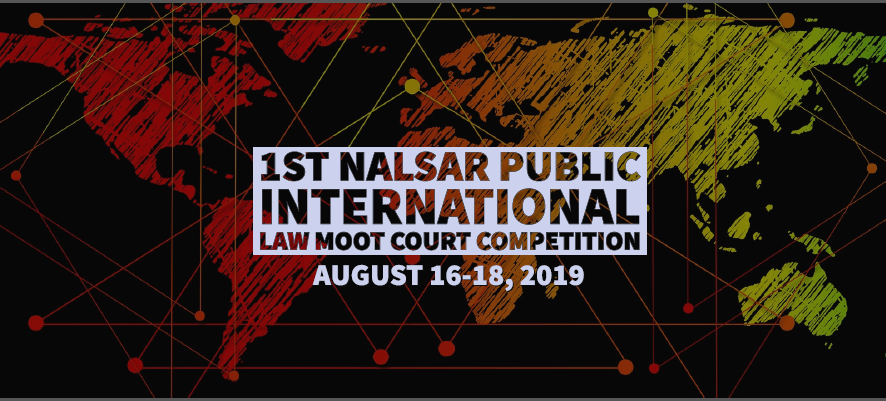Hello everybody!
NALSAR University of Law welcomes you to the 1st edition of the NALSAR Public International Law Moot Court Competition, 2019 live blog. The competition will be held from 16th to 18th August 2019, with the support of Eastern Book Company and SCC Online, Indian Society of International Law (ISIL) and Enhelion as knowledge partners. The competition will see participation from 24 teams going head to head in preliminary rounds, followed by quarterfinals, semifinals and of course, the much-awaited finals.
Schedule of Events:
16th August – Registration, Inauguration, Researchers’ Test, Exchange of Memorials
17th August – Preliminary Rounds, Quarterfinals
18th August – Semifinals, Finals
Look forward to all the highlights and results of this competition being updated right here. Expect the highlights and results of the prelims followed by comprehensive live updates of the Quarter Finals and Semi Finals. The Final Rounds will be live-streamed.
16th August 2019 – Friday
4:30 p.m. – The teams have arrived and registrations are underway at the Jhunjhunwala Hall.
5:10 p.m. – The inauguration ceremony is about to begin in the Jhunjhunwala Hall.
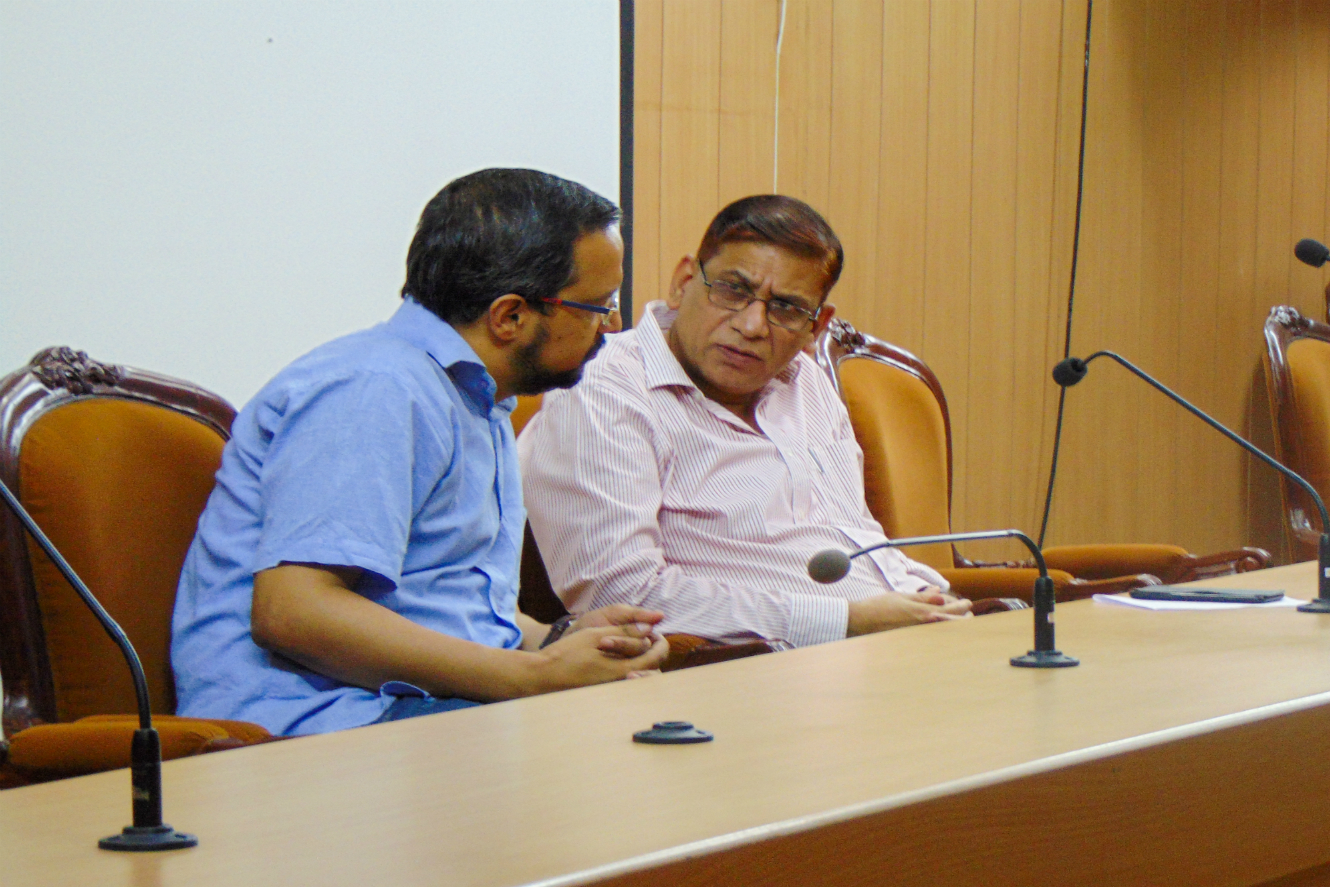
5:15 p.m. – Sushrut Kaplay, the Head of the Organising Committee takes the stage to welcome the teams and thank our knowledge partners Eastern Book Company and SCC Online, Enhelion and Indian Society of International Law (ISIL). He congratulates the participants on making it here to the oral rounds, considering the fact that out of 47 registrations, only 24 of them have qualified. He extends an invitation to Sidharth Chauhan sir to open the competition and address the participants.
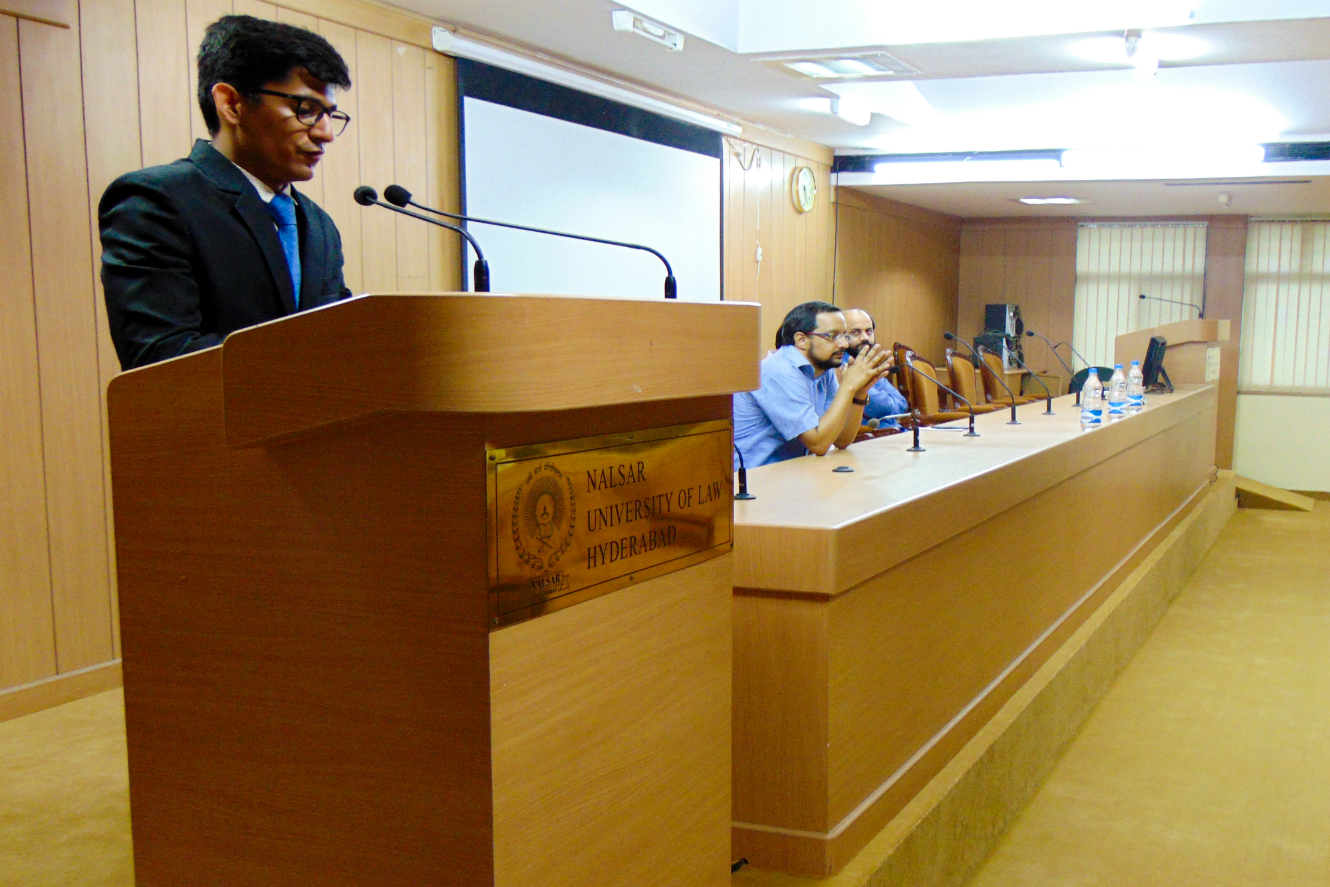
5:25 p.m. – Sidharth Chauhan sir takes the stage to talk about NALSAR’s vision with regards to mooting. He says that competitions are not just about winning or losing, but about developing skills and capabilities. He further reaffirms the participants that this will be a completely transparent tournament.
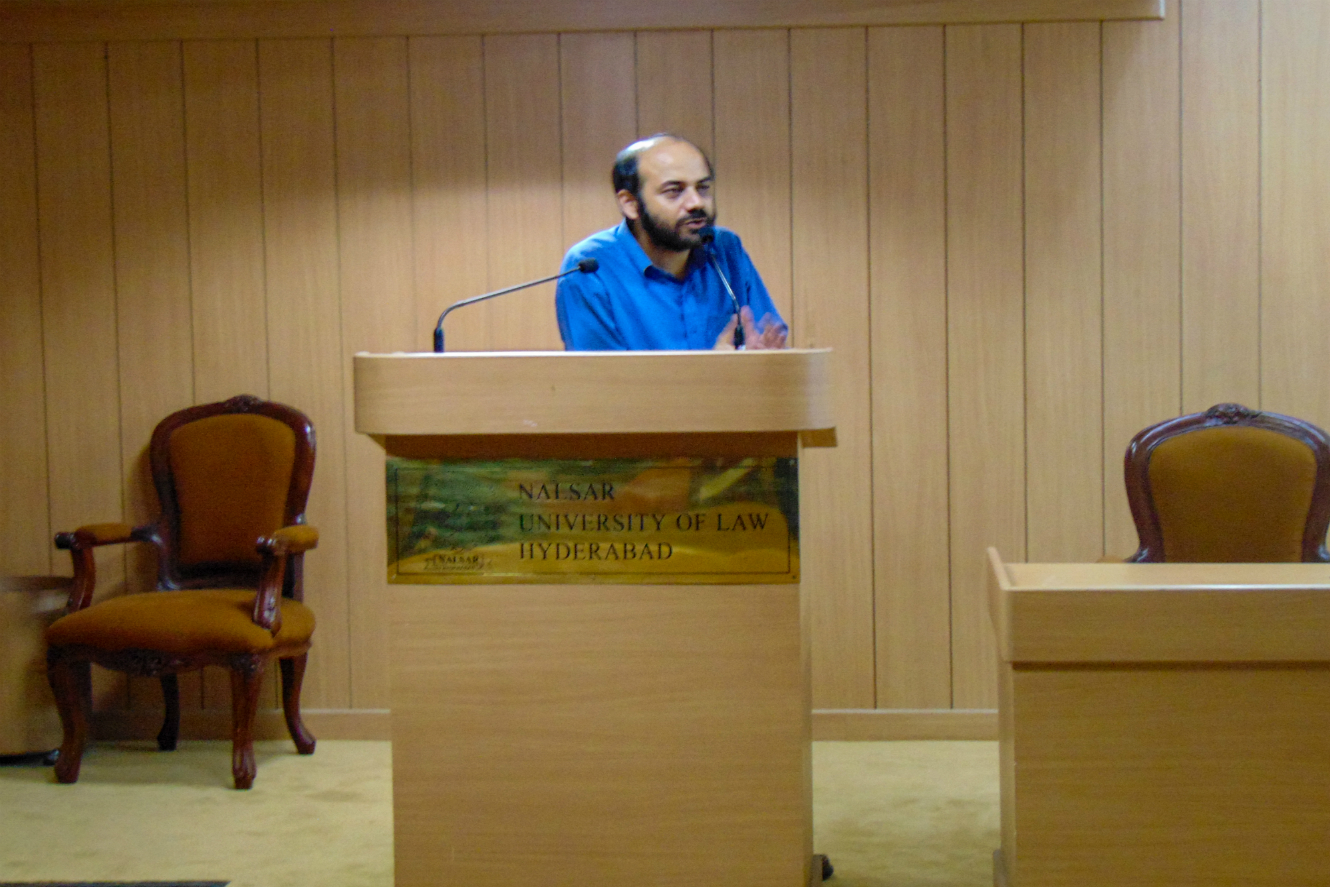
He also says that through this initiative the aim is to enable students to develop strong connections and networks in the mooting circle, and also to help them further their knowledge in the field of public international law. He wishes the teams luck and hands over the stage to Sushrut.
5:33 p.m. – Sushrut Kaplay explains the rules of the competition and also regarding the seeding and match-up process. Further, he also clarifies the process for deciding breaks and the qualifying teams.
5:35 p.m. – Researchers test will begin at 6 in classroom 1.
6:00 p.m. – Researchers test is underway in classroom number 1.
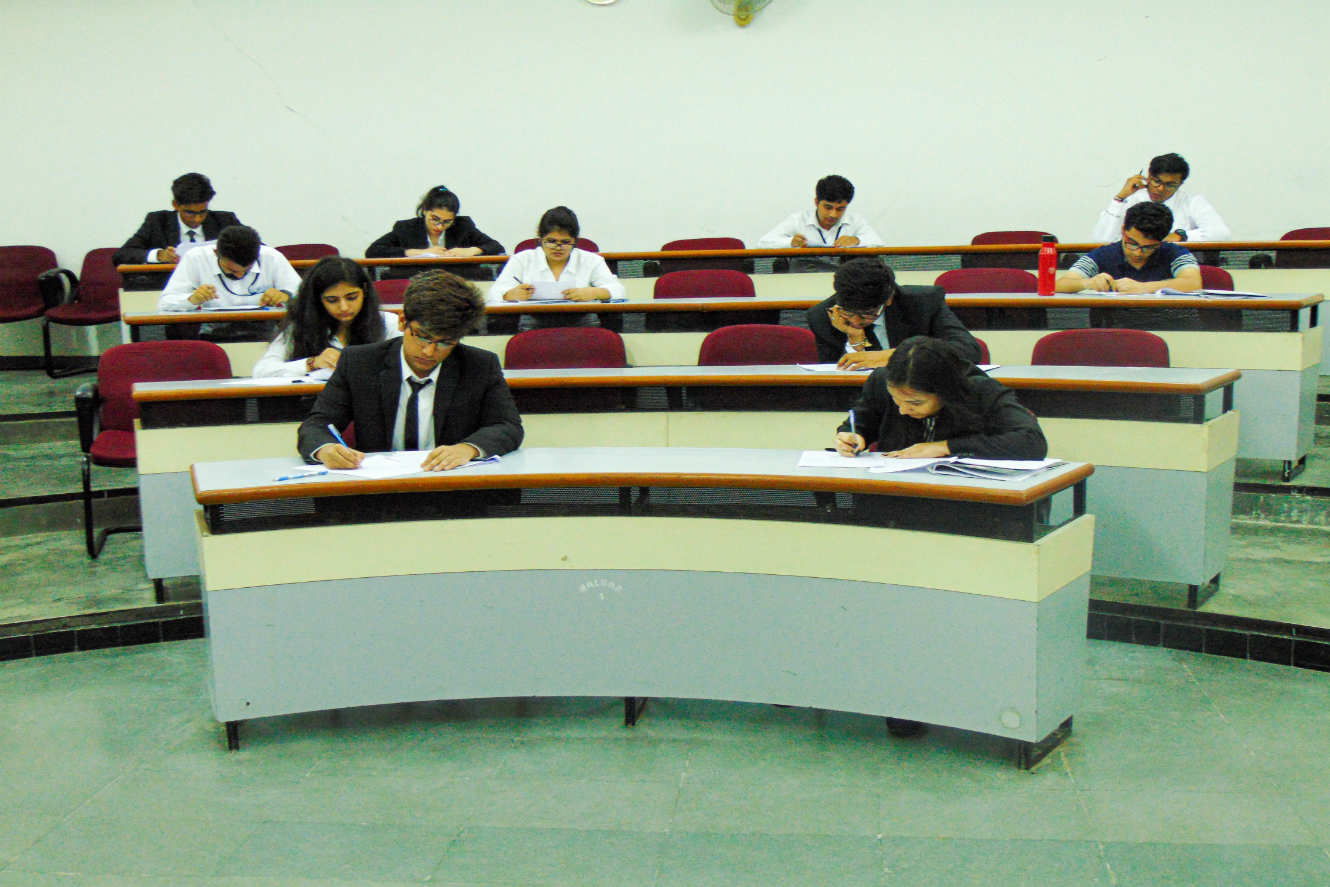
6:30 p.m. – The match-ups are announced and memorials are being exchanged in Jhunjhunwala Hall.
17th August 2019 – Saturday
9:45 a.m. – The briefing for judges is happening in the Jhunjhunwala Hall.
10:15 a.m. – Preliminary Round-I has begun.
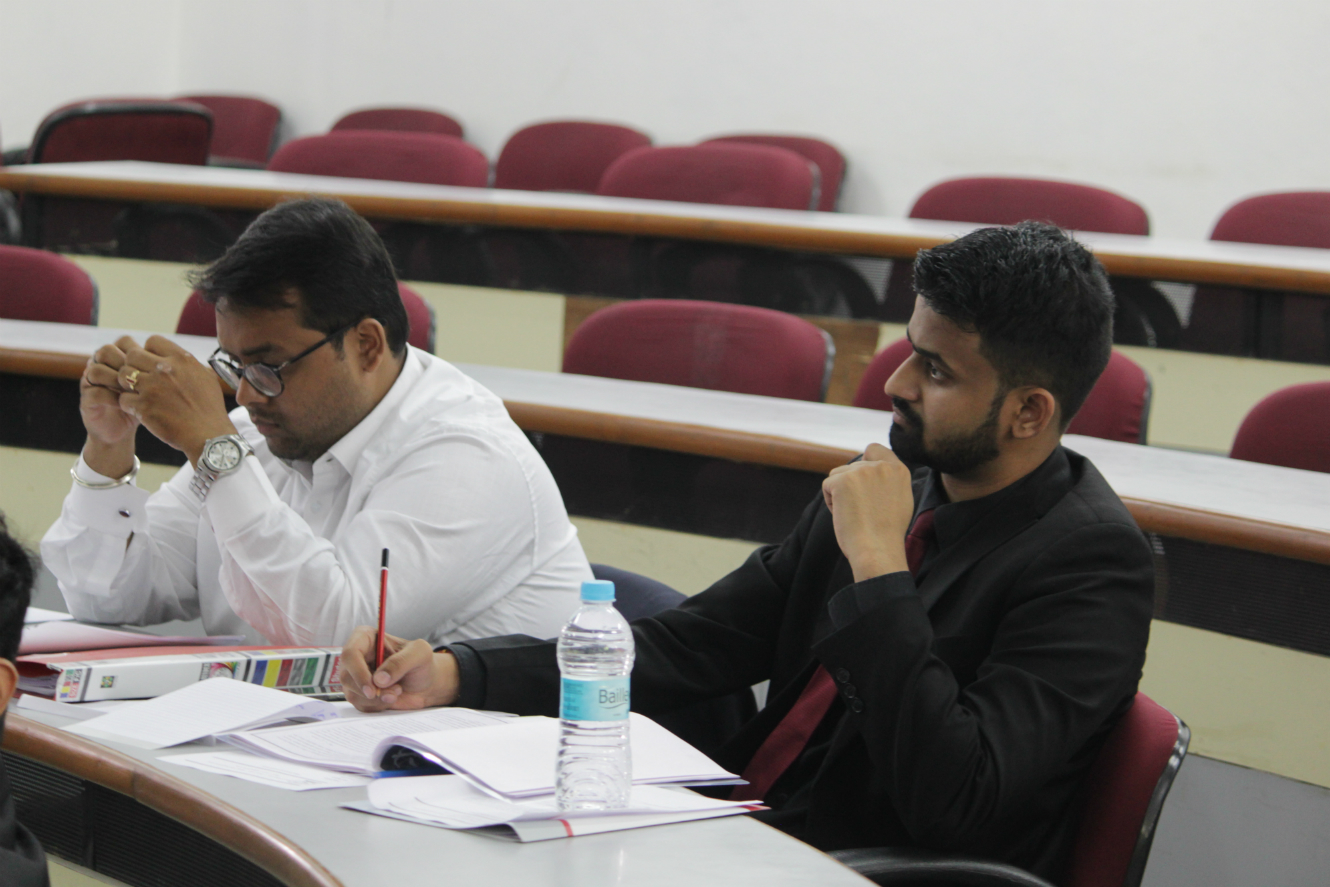
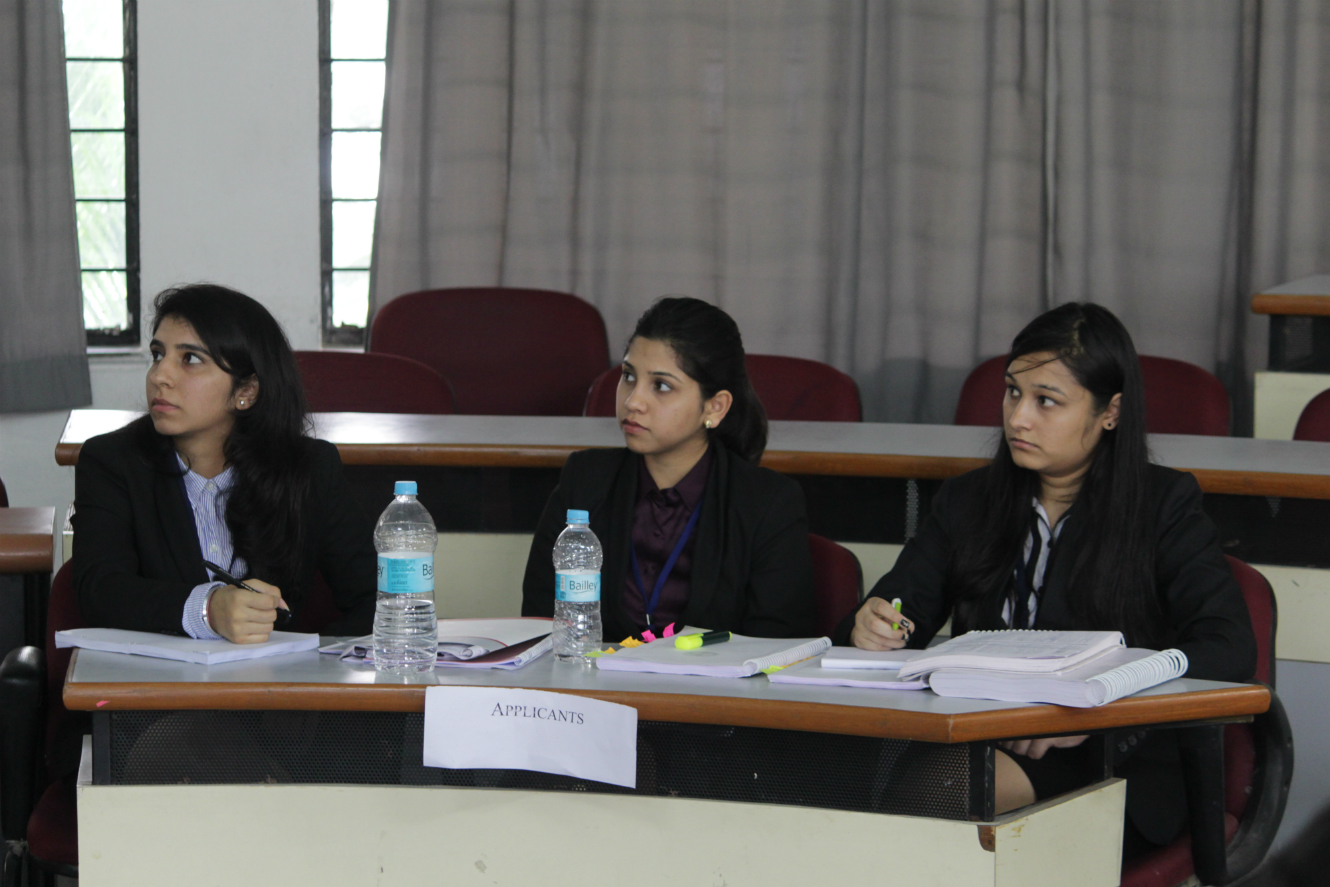
11:30 a.m. – Preliminary Round-I has concluded.
11:45 a.m. – Preliminary Round-II has commenced.
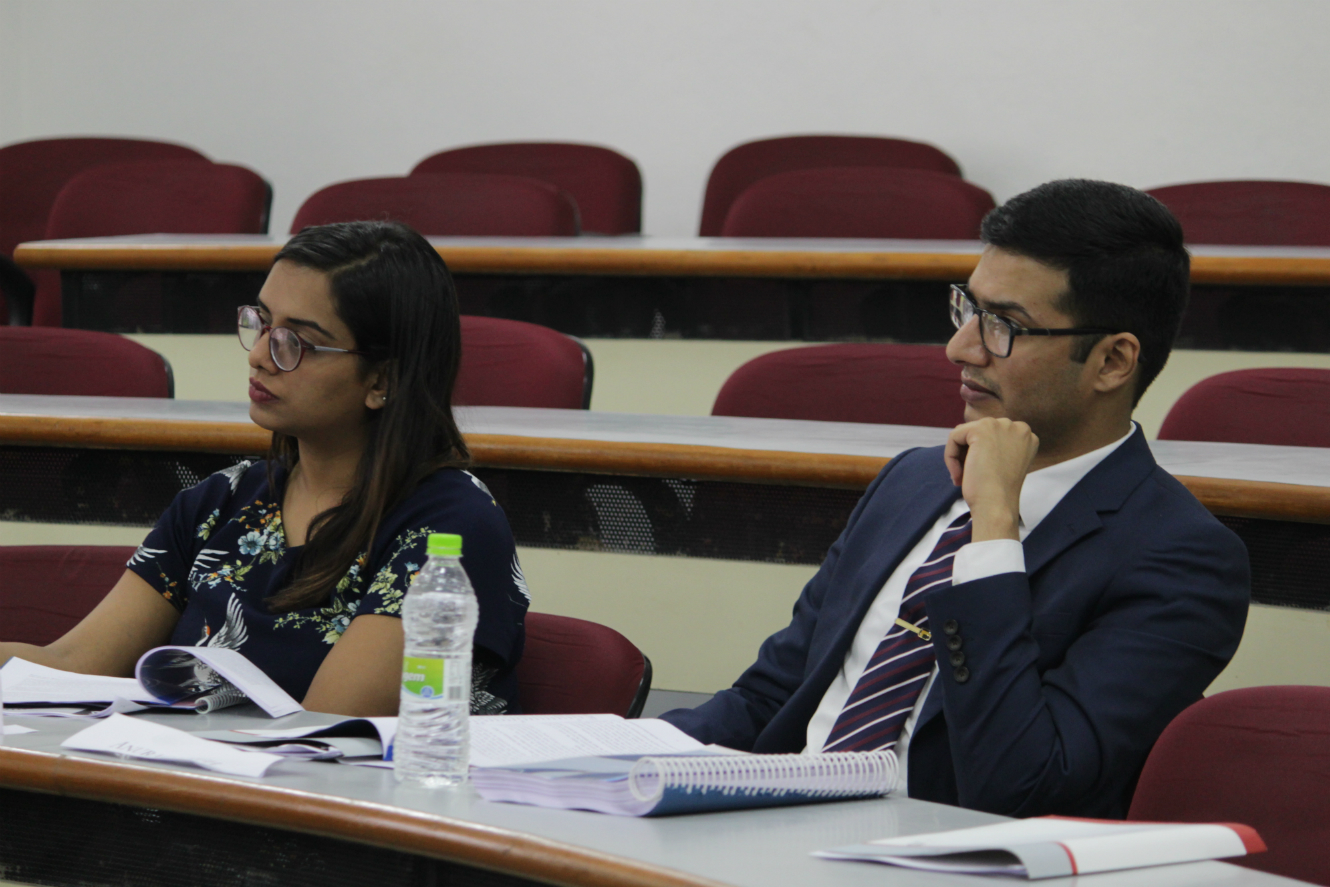
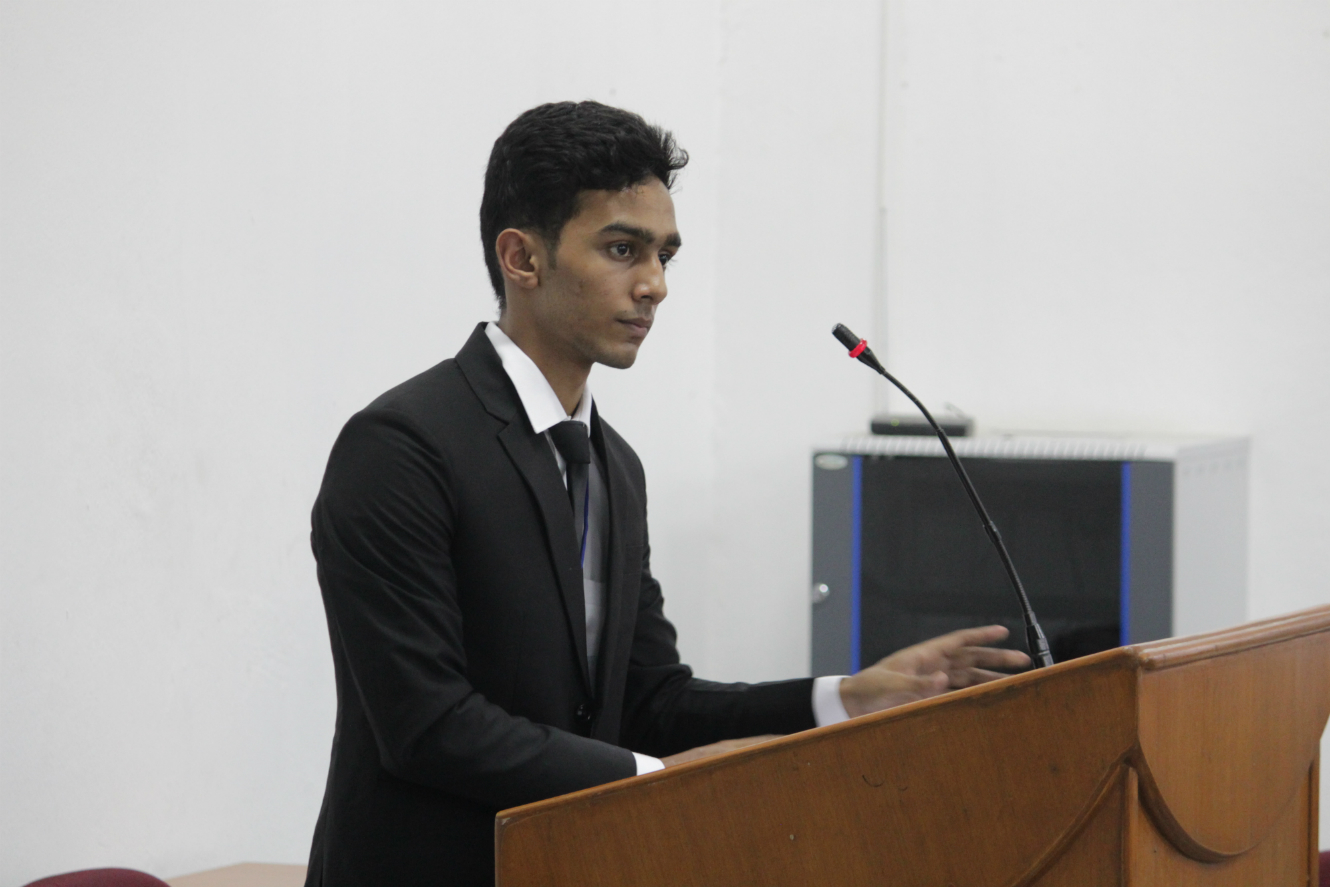
1:10 p.m. – Preliminary Round-II comes to an end.
1:30 p.m. – Preliminary Round-III is in full swing.
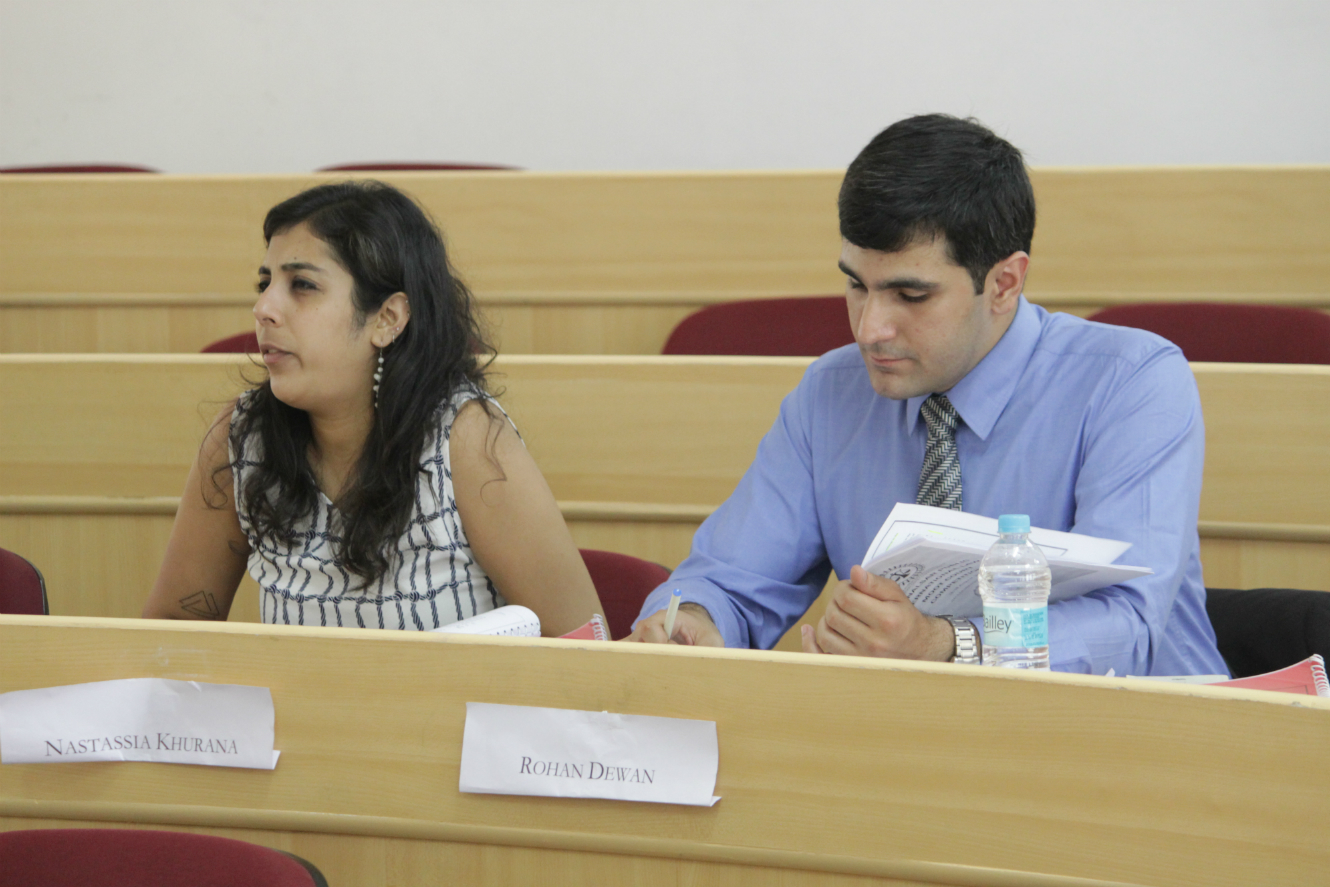
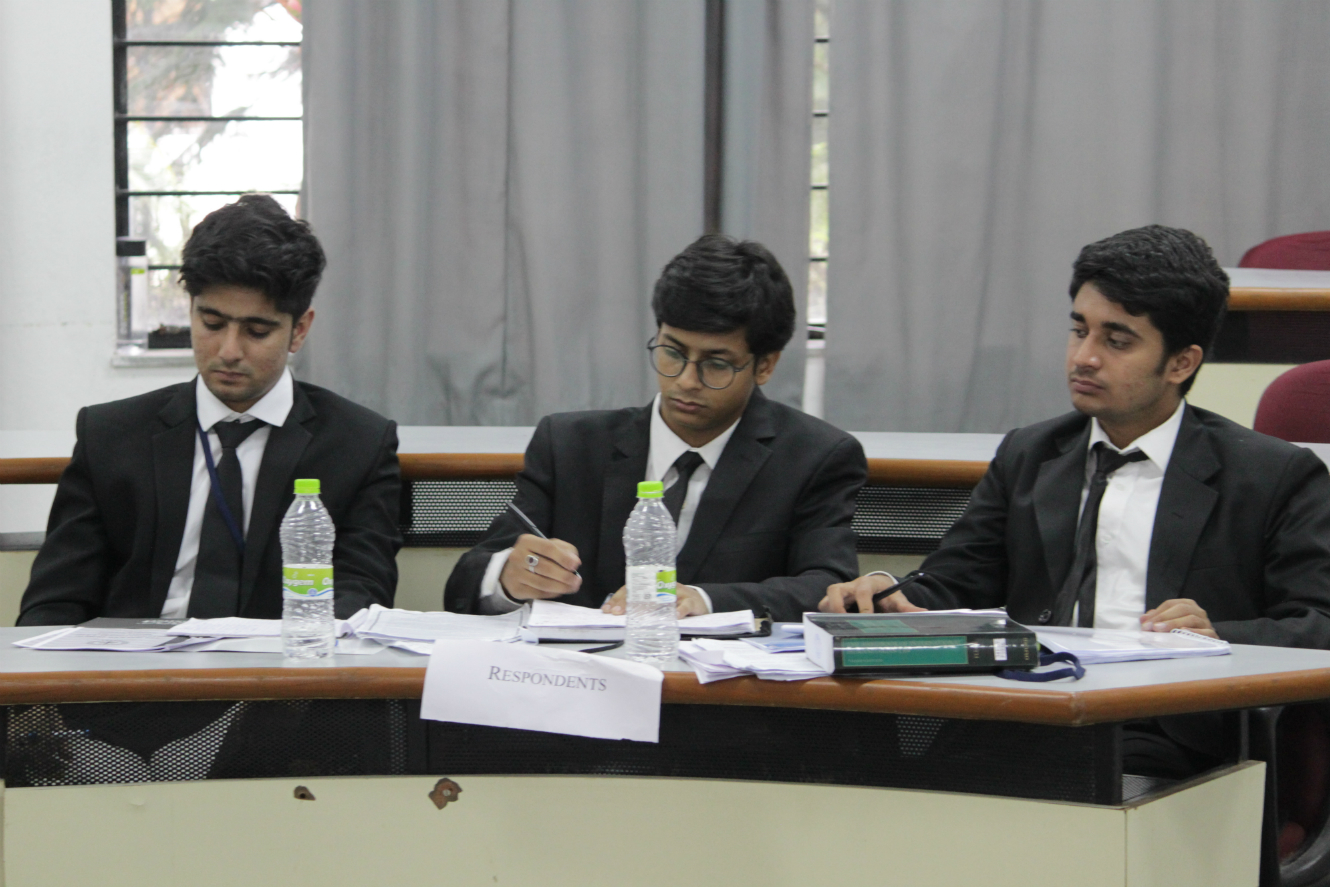
2:40 p.m. – Preliminary Round-III has come to a conclusion.
2:55 p.m. – Preliminary Round-IV is underway.
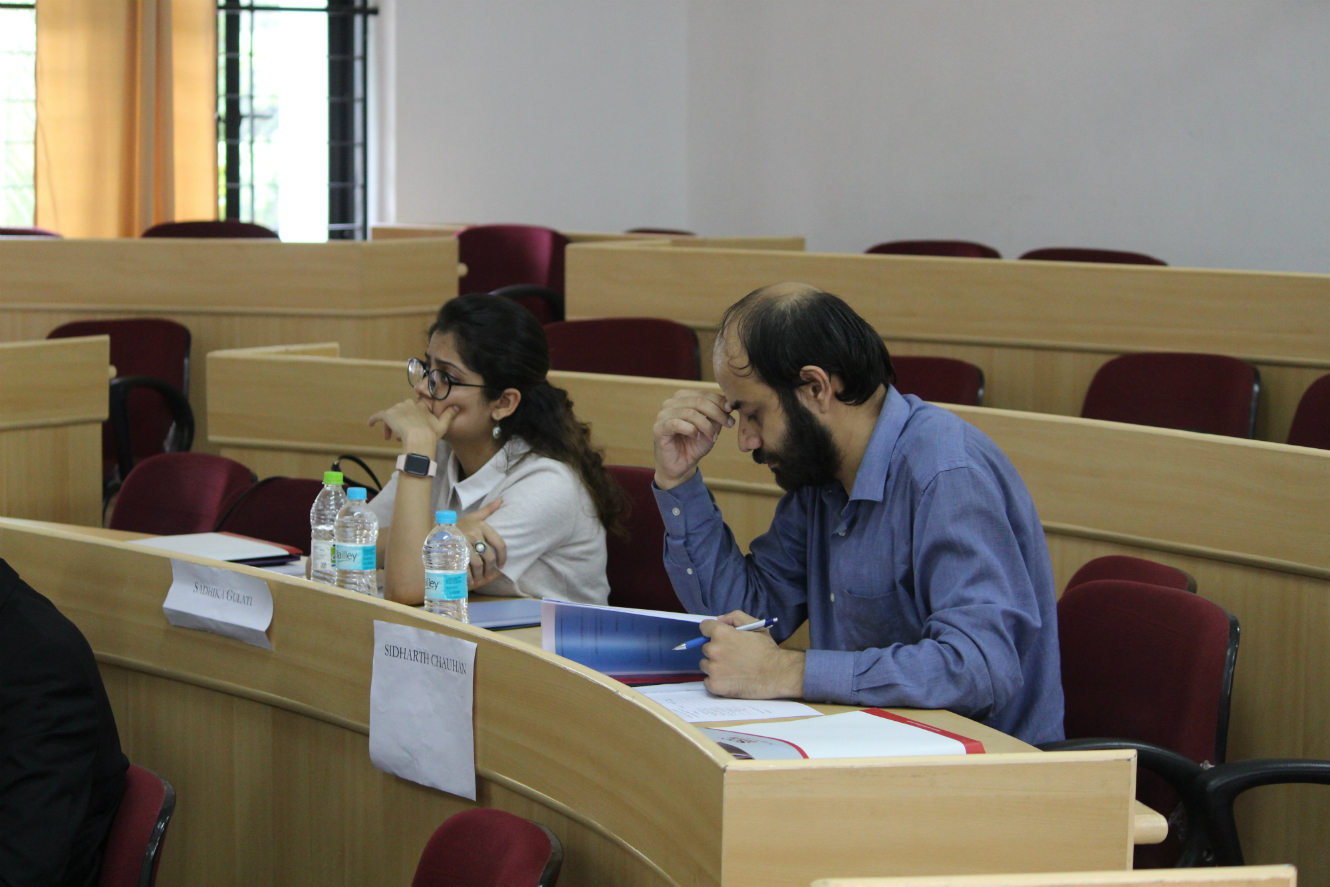
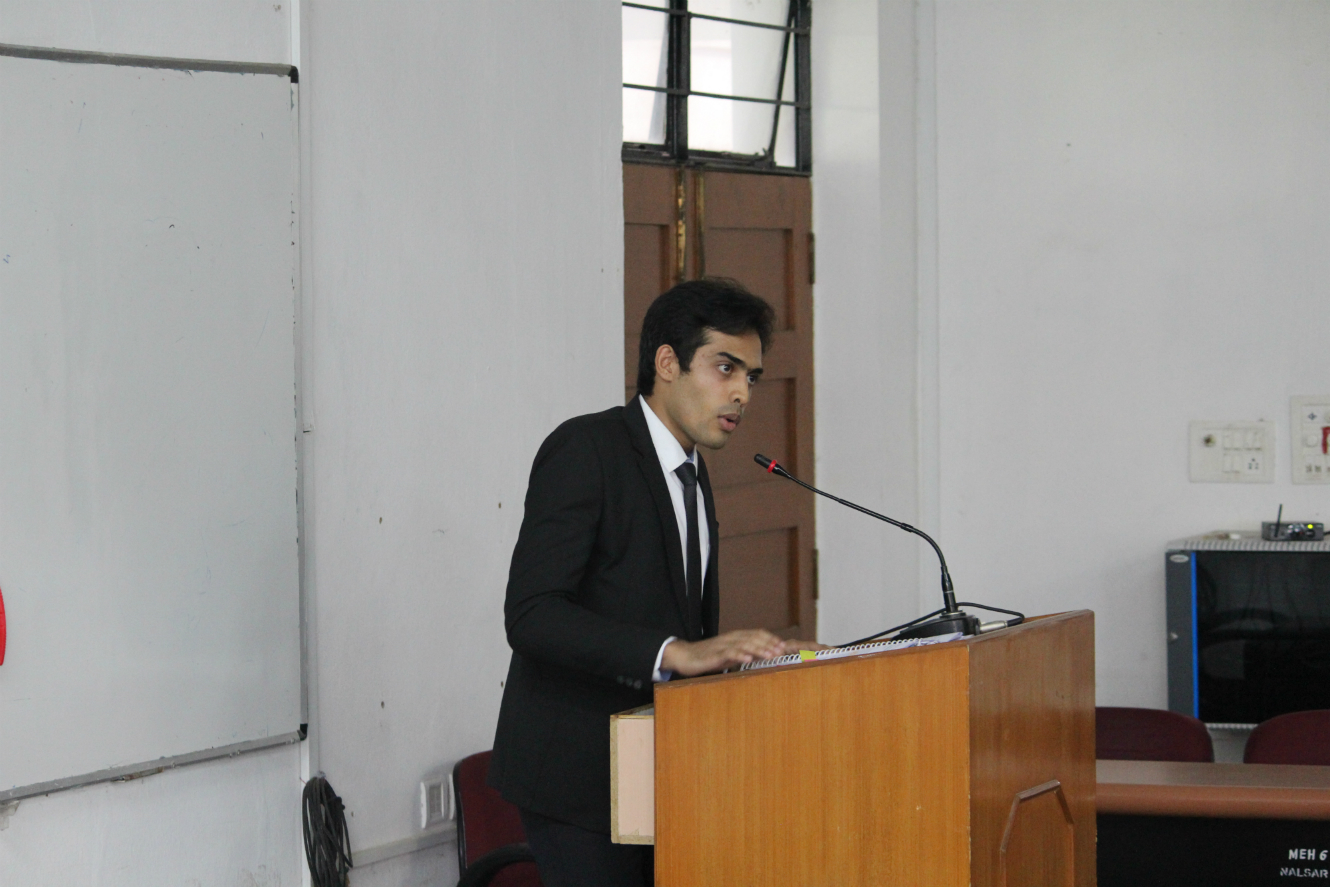
4:15 p.m. – Preliminary Round-IV has come to an end.
4:55 p.m. – All the teams have gathered in the Jhunjhunwala Hall and there is nervous excitement in the room as the participants are waiting for the results of the Preliminary Rounds to be announced.
5:00 p.m. – The teams which have qualified for the Quarter Final Rounds, in no particular order, are:
- Jamia Millia Islamia University, New Delhi
- Symbiosis Law School (SLS), Pune
- Lloyd Law College, Delhi NCR
- Tamil Nadu National Law School (TNNLS), Tamil Nadu
- Chanakya National Law University (CNLU), Patna
- Institute of Law, Nirma University (ILNU), Gujarat
- School of Law, Christ University, Bangalore
- Rajiv Gandhi National University of Law (RGNUL), Patiala
5:25 p.m. – The Quarter-Final rounds have begun.
QUARTER FINALS
Court Room 1
Judges – Rahul Mohanty and Karan Gupta
Claimant, Speaker 1:
5.39 PM: The speaker explains the framework of his arguments and informs the bench that the contention of ‘Use of Force’ will be dealt by himself. While, the second contention will be dealt by his co-counsel.
5.40 PM: The speaker begins by arguing that the use of force, is a violation of Art. 2(4).
5.41 PM: The bench questions if this contention is relevant, and that only the contention of exceptions need to be dealt with under Art. 51.
5.42 PM: Counsel seems flustered, but regains confidence and begins arguing the contention of Art. 51.
5.43 PM: The bench has asked the counsel a series of questions, to which the answers of the counsel seem unsatisfactory.
5.45 PM: The bench has asked a series of questions in regards to Art. 51, and its interpretation in context of ‘Equality of States’, ‘Right to self defence’, and the role of non-state actors in this regard.
5.47 Pm: The counsel cites various case laws of this court, to stress his point.
5.48 PM: The bench has asked a series of questions related to the facts, to which the counsel seems to be giving quick and adequate answers.
5.50 PM: The bench is curious to determine the true nature of ‘AUF’ and its relation to the Claimant State, in furtherance of which a chain of questioning has been initiated.
5.52 PM: Considering the time pressure, the counsel tries to move on to his next contention, but is interrupted by the bench and is asked to further elaborate.
5.54 PM: In response to a question, the counsel emphasized that the states need to resolve disputes by peaceful means first.
5.55 PM: The counsel requests for extra time to answer a question and summarize his arguments, which is granted.
Claimant, Speaker 2:
5.57 PM: The speaker has confidently begun his arguments, by laying down the framework of his arguments, but is cut mid-way by the bench.
5.58 PM: The counsel continues and breaks his argument in 3 limbs. Begins to argue that there is an armed conflict underway.
5.59 PM: The bench questions the counsel on facts, by asking when the conflict has started.
6.00 PM: The counsel seems startled by the question, tries avoiding it but fails. The claimant team has passed a chit to the speaker.
6.02 PM: The counsel moves on to his second contention, that the Respondents have made no distinction between civilians and armed officials, resulting in many civilian casualties.
6.03 PM: The counsel emphasizes that both ‘AUF’ and ‘FRE’ are non-combatants.
6.07 PM: The counsel is questioned on the facts and the contention of proportionality.
6.10 PM: The counsel finishes his speeches, asks for extra time to argue the third limb of argument, which is denied.
Respondent, Speaker 1:
6.12 PM: The Counsel for Respondents begins her speech, and explains the time structure of her arguments.
6.13 PM: The Counsel argues that the use of force by the respondents, is legitimate considering right to self-defence.
6.15 PM: The bench questions the counsel, and asks to give some examples of state practice to substantiate her arguments.
6.16 PM: The counsel stressed that the jurisprudence in relation to Art. 51 has changed substantially, after the 9/11 attacks.
6.20 PM: The counsel moves onto the next contention and argues that the force used by the Respondent is proportionate and necessary.
6.21 PM: The bench has asked the counsel a couple of questions upon facts.
6.25 PM: The Counsel cites prof. Brownlie to emphasize her point, that non-state actors like terrorist org. Have capacity to inflict serious damage. In light of which the states should have a right of self defence, against non-state actors as well.
Respondent, Speaker 2:
6.29 PM: The counsel seeks to argue about the legitimacy of bombings committed by the Respondents.
6.31 PM: The bench asks if the Respondents agree with claimants, on the point that this is an international armed conflict. The counsel answers in negative, but argues that this is a transnational armed conflict.
6.34 PM: The counsel while presenting his argument, commits a ‘faux pas’ and alleges that the claimant has failed to protect their civilians. The bench asks if the Respondents agree that they killed civilians. The counsel refuses to acknowledge that civilians were killed.
6.36 Pm: The bench asks the counsel to present arguments, disputing the killing of civilians.
6.37 PM: The bench asks a series of questions related to the facts, to which the counsel has given satisfactory answers.
6.42PM: The counsel sums up and concludes his arguments in the last 1 minute.
Rebuttal, Claimant:
6.43 PM: The claimants question the authorities and sources cited by the respondent. Argues that the ‘enabling and unwilling test’ is not a part of opinio juris.
Sur-Rebuttal:
6.46 PM: The respondents present a 3 pronged sur-rebuttal, effectively rebutting 2 points raised by the claimants in the rebuttals, and 1 in the actual speech.
Court Room 2
Judges – Tarun Gopalakrishnan and Bhavini Singh
5:32 P.M. – The quarter finals kick off after a minor delay. Speaker 1 seeks permission from the bench to speak.
Speaker 1, Applicant
5:33: The judges warn the speaker that cannot exceed time at any cost. Asks him to skip directly to the arguments.
5:34: The speaker begins laying down the roadmap for his speech without any interruption from the judges.
The speaker begins his first argument. He sounds confident and the judges seem to pay attention without interrupting.
5:35: The speaker quotes multiple authorities to substantiate his argument. He lays down case laws as well as statutory law.
5:36: The speaker continues speaking – the pace of his speech slightly fast and tone being assertive.
5:37: The speaker makes reference to his written submissions. The judges still paying complete attention turn their pages to reference made. There seems to be no questions on the reference so made.
5:38: He requests for a “conjunctive reading through a literal interpretation” of his argument. Judges look slightly taken aback understandably!
5:39: The speaker seeks permission to proceed to the second argument. The judge wishes to question him on his first argument. The speaker seeks to answer the same in a two pronged manner. The speaker seems to be faltering with his voice breaking apart somewhat.
5:40: The speaker pleads in response to the question that the legislative history behind law is not clear. Bhavini goes on to further question the speaker. The speaker attempts to answer but Bhavini doesn’t seem convinced. Whatever he argues his teammates seems to nod. No similar response from the judges end though.
5:42: Tarun asks him to move on to his next argument.
5:43: The speaker makes continues references to his written submissions. The judges flip the pages of the memorial to find the reference. Only three minutes remain within his permitted time.
5:44: His teammates randomly get up to hand over the compendium to judges in the middle of the round. (not so clever tbh :p)
5:45: The speaker explains lucidly what the test of proportionality stands for. The judges seem to be convinced by such an explanation.
5:46: There is only a minute left to his speech. Tarun stops the speaker and makes it clear that he has a couple of questions lined up.
5:46: The speaker terms the judge’s question as a “pertinent one”. The judges don’t seem convinced with the answer. The speaker now remarks “do I sense a concern there?”.
5:48: The speaker ends his speech making way for his co-speaker.
Applicant, Speaker-2
5:49: The speaker lays down the flow of his speech and judges seem to have no objections.
5:50: The speech delivery seems to be fast and the tone slightly aggressive with a lot of hand movement.
5:51: He throws around an ocean of precedents. The judges seem to be confused. Bhavini asks if this argument is present in the applicant memorial. The speaker refers to the exact paragraph.
5:52: Tarun asks what are the exact violations that they are arguing and asks the speaker to specifically focus on the humanitarian law part.
5:53: The speaker makes continuous references to the written submissions. He seems to finally have gotten the undivided attention of the entire bench. The judges pay close attention without interrupting.
5:55: The speaker has completed two whole minutes without any interruption from the judges. The weird practice of his teammates handing over the authority to the judges in the middle of the round continues!!
5:56: Three minutes without any interruption. The speaker seems to have gotten a proper grip over his speech.
5:58: Five whole minutes of undivided attention (probably tired I guess). The speaker though is going extremely fast at this point.
5:59: Finally a question comes through where the Tarun asks him to skip this argument and asks him a specific question. The question has taken the speaker aback slightly. Bhavini asks the speaker to concede on the point. The speaker is slightly hesitant but still holds ground.
6:00: Tarun asks the speaker a specific question on the argument relating to ICCPR.
6:02: A specific question on what arbitrariness means is posed to the speaker.
6:03: The counsels specifically state that throughout their submissions they have maintained that the second airstrike was targeted at civilians and not with a military objective.
6:05: The judges seem to have no further questions.
Respondent, Speaker 1
6:06: The speaker explains the division of time between himself and co-speaker. He goes on to state the roadmap of his speech without any interruption from the judges.
6:07: He argues firstly that an armed attack by non-state actors qualify as armed attack under Article 51 of the Charter. Tarun asks him to focus on his argument pertaining to state practice.
6:08: The speaker refers to several General Assembly Resolutions, Israel’s attack on Hamas not receiving any condemnation & same with both Turkey and the recent Balakot strikes.
6:09: The judges seem to have no problem with the analogies drawn. The speaker goes on to cite judicial opinions on what an armed attack by a non-state actor means.
6:10: He starts explaining the test of proportionality and how the same falls on their side. The speaker lays down his argument on the doctrine of necessity. The speech delivery of the speaker is the following: pace – neither too fast nor too slow and tone: engaging. References are made to the memorial to substantiate the argument.
6:11: The judge interrupts and asks if the speaker has any other argument apart from proportionality. Tarun asks the speaker to focus specifically on state sovereignty argument.
6:13: The speaker refers to the Corfu Channel case and explains how the same falls on their side. He has the undivided attention of the judges. His calm and composed speech seems to be well taken by the judges.
6:14: Bhavini and Tarun both now pose questions with respect to this submission. Bhavini asks if this court has ever recognised the doctrine of clean hands. The speaker takes him to a dissenting opinion which recognises which is followed by a counter-question of whether there is any authoritative value in a dissenting opinion?
6:16: Tarun questions the speaker regarding what exactly is an amenable time to respond to a terrorist attack. The speaker uses the doctrine of necessity to support his argument. He draws an analogy to the Balakot airstrike. Quick counter-question from Bhavini if the Balakot airstrikes were legal at all?
6:17: Tarun ask if the culmination of the terrorist attack is not a culmination of several years of tension between India & Pakistan.
6:18: The judges do not seem convinced and pose a completely new legal question to the speaker.
6:20: The permitted time for the speaker is over and he tries to sum up his answer by citing Nagendra Singh’s opinion in the Nicaragua judgment.
Speaker 2, Respondent
6:21: The speaker explains what exactly is needed to be argued in the second issue. Then moves on to his first submission directly.
6:22: The speech delivery is as following: speed: perfect tending towards slow. Tone: extremely engaging with specific emphasis on usage of authorities.
6::23: The speaker in his second submission claims that there was no indiscriminate action present in the actions. He cites the definition under the Additional Protocol. He argues that there was a certain degree of military advantage and that this was under military objective.
6:25: He argues that there was substantial military necessity in the present case even when substantial loss of lives of civilians occur. He cites previous opinions of the ICTY to substantiate his argument.
6:27: He continues argument without any interruption from the judges. He argues that in the present case practical measures were undertaken to minimise civilian casualties.
6:28: He goes on to explain the exact engineering of the weapons (attempt to bamboozle the judges). His intent seems to be to explain that the weapons do not amount to indiscriminate military usage.
6:29: The judges question the speaker as to whether he has any further argument. After hearing him out the judges ask him to specifically focus on the humanitarian law argument and wrap up his speech soon.
6:30: He goes on to make a three pronged argument under the ICCPR citing judicial interpretations of provisions. Specific emphasis is put on the fact that the burden of proof is on the applicants to show civilian loss of lives.
6:31: A last question is posed by Tarun regarding interpretation of indiscriminate attack under the additional protocol.
6:32: The speaker argues that the attack was targeted at only military centres and not civilian centres. Tarun directs that there is no proof to show the accuracy of this statement. He goes on to ask him in the abstract as to whether there is any precedent in history of airstrikes where only terrorist camps were targeted.
6:34: The speaker answers by citing the case of American bombings in Kosovo. Bhavini vehemently disagrees with the facts cited.
6:35: A question on why an aerial bombardment and not a military operation. The speaker cites the use of targeted attacking only on terrorist centres.
Court Room 3
Judges – Utkarsh Mishra and Anurag Singh
Speaker 1, Claimant
5:38 PM: The speaker rushes through laying down the structure of the speech but has done a good job laying down a skeleton for the judges to follow.
5:39: the Speaker quickly tackles a question put forth by the judge on the authority being relied upon by her.
5:40: The judge leads with a fact based question and the speaker looks slightly taken back. He answers the question for her and proceeds to asking a longer question.
5:42 PM: The speaker attempts to answer the question by the judge by citing cases from this court itself but fails to convince the judge. The judge continues posing challenging follow-up questions to the speaker.
5:44 PM: The speaker is caught up in still answering the question posed 4 minutes back. She is losing precious time by not guiding them back to her substantive content.
5:45PM: The dispute seems to be on the presence (or lack thereof) concrete evidence. The speaker is getting emotional, table-thumping included, to emphasise their territorial sovereignty.
5:47 PM: The speaker discusses the first bombing to state that there were no death they could accord to the attack however the second attack had concrete evidence of deaths. The judge asks her to confirm if there have been killings in the first attack as well. The Speaker agrees. The judge remains silent, possibly in the hope of her understanding where he wanted to lead her.
5:49 PM: As soon as the speaker resumes, the judge tells her clearly she’s incorrect.
5:50 PM: The judge asks the speaker to show them proof that the deceased people in the second attack were civilians. He poses her own question on concrete proof back to her- whether they have concrete proof that each individual was a civilian or could’ve been a non-state actor. She concedes as a result of her previous emphasis on concrete evidence (when it worked in the their favour).
5:53 PM: the Speech is briefly interrupted as anxious teammates seek permission to pass chits. However, the speaker rejects looking at the chit (to the amusement of everyone in the room). As her time is up, she asks the judges to wrap her submissions.
5:54 PM: Alas, even in the last minute, the speaker piques the judges’ curiousity and is stopped for further questioning.
5:57 PM: This is nowhere near over as the unsatisfied judges pose further questions and the speaker tries to put up a brave face. The judges are ignoring the bailiff’s attempts to tell them time’s up.
5:59 PM: Finally, the speaker ends answering the final question, but it is uncertain whether the judges were happy with any of the answers.
Claimant, Speaker 2
6:00 PM: In less than a minute, the second speaker has already started, speaking so quick that this reporter’s fingers failed to catch the first minute wherein he laid down the structure.
6:01 PM: The judge tells him that they will assertions he needs to prove in his speech -1) All of them were civilians and 2) it was not proportional. These two are the most important issues for the judges.
6:04 PM: This speaker seems confident while answering the question, though the judge doesn’t seem satisfied. But the amount of times the speaker has used ‘Your excellency’ by now can be a drinking game.
6:05 PM: The question of the nature of 32 people comes up here as well except this speaker brings in corroborative evidence to support his assertion that those people were civilians.
6:06PM: The judge interrupts him to proceed to answering whether this was an armed conflict or not. The speaker begins with an affirmative response and goes on to provide the reasoning. He seems to be armed with a lot of information but his pace makes it hard to follow.
6:09 PM: The speaker has citations on the tip of his fingers, including volume and page number of the commentary which seems to add an air of authority to his argument. His flow breaks for a split second but he regains composure quickly.
6:10 PM: The judge says that the proportionality agreement can only be bought if the speaker provides them concrete proof that the people killed were civilians. The other judge states that even if the speaker fails to prove they were civilians, he should prove that this set of people required protection under international law.
6:12 PM: The speaker cites various authorities of recent ICJ cases to state that media reports can be relied upon. International media has reported death of 32 persons but when one looks at the whole set of circumstances including the actions of the claimant, the threshold for corroborative evidence is fulfilled here.
6:14 PM: Since the speaker’s time is up, the judges ask him to summarise his arguments. The end of his speech for much more peaceful than his teammate’s as the judges did not pose questions.
Speaker 1, Repondent
6:17 PM: The speakers start off loud and clear, laying down the claimant’s submissions that the respondents will seek to rebut.
6:18 PM: The speakers seems equipped with filler phrases even as the judges start grilling him such as, ‘it is a pleasure to argue before the court’ as he proceeds to answer the questions.
6:21 PM: The judges are surprised and slightly worked up about the speaker’s assertions on the obligations of the Applicants after the attack. The speaker tried to proceed with his speech but the judge told him that the question had not been answered and brought him back to it.
6:23 PM: Though the speaker used the phrase ‘It is a pleasure to answer your query’ but the preceding interaction doesn’t make this sentiment seem genuine!
6:26 PM: Power being out has put a slight damper on things. Hopefully NALSAR generators don’t fail us this time.
6:29 PM: speaker resumes with a member from the organising committee holding up a torch light for him to see his notes. This moot has been a team effort in more ways than one. The pause was also blessing to the speaker as he was in the middle of intense questioning before this.
6:33 PM: The judge asks why the respondent failed to talk before the media before the suicide bombings? The speaker believes that they did speak to the media when required.
6:34 PM: The judge asks why they didn’t go to the UN security council to impose sanctions. However, the speaker cites the Nicaragua judgment to say the ICJ accepted the state not going to the UNSC. The judge disregards it, stating that it is not binding on them and to justify the actions in light of the UN Charter being in place to prevent war.
6:36 PM: Contrary to the speaker’s reliance on USA, the judge says we cannot talk about the USA because it kept changing its position. “There was no state practice, it was political practice”.
6:37 PM: The speaker states that they did not go to UN because of imminent threat. He elaborates on the same.
6:38 PM: The discussion seems to be going in circles as the judges emphasise the responsibility to go to the UN and the speaker diminishes this responsibility based on right to self defence. The judges now seem amused by the speaker’s steadfast stance on this.
6:40 PM: The speaker seems flustered now, even cutting off the judge. The speaker has lost precious time emphasising the same points. The judges look defeated as they try to explain the logical fallacy in the speaker’s arguments for the nth time.
6:43 PM: The speaker finally rests his case and looks exhausted after a grilling round. Props to him for not giving up and maintaining composure till the end!
Speaker 2, Respondent
6:45 PM: Within the first minute of the speaker’s time, the judges start the questioning. She clearly states that she will answer their question in 3 parts, thereby effectively laying down a structure.
6:47 PM: The question of the deceased people comes up here as well. The judges are now posing questions on why the people are not civilians as per the Respondent’s assertions. The Speaker proceeds to give multiple assumptions to draw inferences from.
6:50 PM: The speaker comes to the International media reports as evidence in their support. She states that they all can’t be considered civilians. The judge then rebuts asking if we should consider the civilians 50% of the deceased then. The speaker fails to prove why her assertion of none of the deceased being civilians is correct.
6:52 PM: This speaker has been much more emotive than the others, though she keeps her calm during questioning.
6:53 PM: The judge states that the speaker is manufacturing facts to work in their favour.
6:55 PM: The judge is prepared with one last big question. Why should the AUF be allowed to do something and not FIU? The speaker attempts to answer but fails to impress that judges as they state that they’ve repeated the same thing 10 times without the respondent effectively addressing it.
6:57 PM: as the respondent seeks to go back to her speech, the judges ask her to address the question of armed conflict and whether it was an international or non-international armed conflict.
6:58 PM: The teammates seem to be discussing something urgently as the round is coming to and end. The claimant speaker 1 can be seen fervently jotting down points.
6:59 PM: The judges ask for additional new information from the speaker to substantiate their points as they’ve heard the same line of argument multiple times but the speaker doesn’t seem to have addressed this sufficiently.
7:01 PM: The speaker finally ends the speech and looks relieved to be away from the podium.
REBUTTALS
Speaker 2, Claimant
7:02 PM: The speaker seems confident while rebutting them on fundamental points such as the fact the respondent speaker claimed it was a non international armed conflict but relied upon the Protocol which only applies to international armed conflict.
Speaker 1, Respondent
7:03 PM: The judges cut off the speaker to clarify that sur-rebuttals cannot be used to make new claims- a pivotal point that should’ve been known by the speaker beforehand.
7:04 PM: The sur-rebuttals are more of an emotional appeal than logical rebuttals to the arguments.
Court Room 4
Judges – Nastassia and Juhi
5.30 pm: Quarter Final rounds have begun in Room 4 after a minor delay.
Claimant, Speaker 1
5:32 pm : The claimant speaker 1 has began the round stumbling while laying out the framework of the issues.
5:34 pm : The judge(s) warn the speaker not to argue points that have not been contested.
5:37 pm : The speaker is met with a barrage of questions and pauses to collect his thoughts. He refers the judges to a page in the team’s compendium however, is not able to find it.
5:39 pm : The speaker seems to have picked up his pace just to have been stopped by questioning by the bench asking what authority is being relied upon to make his point.
5:41 pm : The bench has exposed the holes in the speaker’s line of reasoning and the speaker seems to be sidestepping the questions from the judges. The bench does not seem impressed.
5:44 pm : The bench highlights how grave the circumstances are and claims that the claimants have malafide intent. Only one minute left and the speaker seems to have run out of excuses.
5:46 pm : The bench continues accusing the claimants and the speaker grins while being unable to answer.
5:49 pm : The bench seems to be convinced that AUF is a terrorist organisation and asks if the claimant is willing to seek time. The judges are breaking down what they expect from the claimant, hopefully, speaker 1 can salvage the rest of his speech.
5:51pm: Speaker 1 is asked to sum up his argument as time has run out. He quickly discusses proportionality and makes his way off the dias.
Claimant , Speaker 2
5:53 pm : Speaker 2 has begun her speech and is interrupted abruptly, asked why she refers to herself as an agent. She swiftly answers the questions and starts of her speech strong.
5:56 pm : The bench questions the speaker about points made by Speaker 1. She clarifies her co- speaker’s points and moves on with her speech.
5:59 pm : The bench grills the speaker on the facts and the speaker claims that such facts are ambiguous. One of the judge’s rains down questions and criticism regarding the speaker’s points. She is merely only able to get out a couple of um’s and ah’s before she can pick up her speech again.
6:04 pm : 3 minutes left and the speaker is not even half way through her speech. The bench seems to have caught her in a web of her own claims.
6:05 pm : The speaker seems to have got back on track quickly moving through her speech. The bench stops her and brings up points from her co-speaker’s speech and share a grin. Hopefully she will pick up on what the judges are pointing out.
6:07 pm : The time is up and the speaker is asked to summarise her points. Just as one would feel like no more questions would be asked the bench has come up with yet another set of queries.This is not looking bright for the claimants.
6:09 pm : The claimants have made their case and anxiously await the respondents to begin.
Respondent , Speaker 1
6:10 pm : Speaker one starts off confidently laying down her road map in a clear and crisp manner.
6:12 pm : The speaker has gone 2 minutes without questioning before being met with questioning from the judge(s). She deals with each question succinctly and thoroughly, however, gets stuck on a basic question.
6:15 pm : The judge and speaker have been engaging in a continuous back and forth. The speaker is showing resolve showing no signs of backing down. This is costing the team precious time.
6:17 pm : The speaker continues with her points. The bench accuses the speaker of misquoting the paragraphs however, the speaker continues trudging on.
6:19 pm : Both the researcher and speaker two are looking worriedly at speaker one hoping that she can make her way out of this sticky situation.
6:20 pm : Speaker is not backing down continuously answering the bench’s questions. It seems as if there is a light at the end of the tunnel.
6:22 pm : The Speaker is making only factual arguments and the judges are not impressed.
6:23 pm : The bench is getting irritated with the speaker’s lack of providing convincing authority. Speaker one quickly wraps up her speech and makes way for her co – speaker.
Respondent, Speaker 2
6:25 pm : Speaker two begins her speech slowly as if expecting a question from the bench.
6:26 pm : The bench starts grilling the speaker on facts and the speaker is made to back track.
6:29 pm : Speaker 2 moves quickly with her speech however, the bench is not impressed and continue questioning the speaker.
6:31 pm : The speaker continues juggle between calling the bench lordships and excellencies while struggling with her speech.
6:32 pm : The bench rejects the usage of Australia as an example and break down their reasoning. The speaker is staring at the bench in awe. The judges question the intent of the bombing and the speaker swiftly replies taking the assistance of government intelligence report. The judges vehemently disagree with the usage of such reports. The speaker seems stumped.
6:35 pm : The judge speaks about protection under IHL whereas the speaker continues reiterating her previous arguments.
6:37 pm : The speaker requests to deal with another contention and the bench denies citing paucity of time.
6:38 pm : The speaker finishes her speech with a whimper after a strong start. Now onto the rebuttals.
Rebuttals
6:40 pm : Speaker two on behalf of the claimants makes her way to the dias and confidently dissects the case of the respondents. The bench nods in approval for the first time this round.
6:43 pm : Speaker two on behalf of the respondents begins the sur rebuttals and quickly addresses points made. The judges seem too tired to ask anymore questions and walk out of the room to deliberate as soon as the round ended.
The quarter final rounds have been concluded in all the rooms.
9:00 pm – There is a nervous excitement in the air as teams are waiting for the breaks for semi-finals to be announced.
The teams that have qualified for the semi-finals, in no particular order, are:
- Symbiosis Law School (SLS), Pune
- Lloyd Law College, Delhi NCR
- School of Law, Christ University
- Chanakya National Law University (CNLU), Patna
All the best to the qualifying teams!
18th August 2019 – Sunday
SEMI FINALS
Semi Final-I
Judges – Srimikundan, Ramachandra Gurram, Himanil Raina
Applicant, Speaker 1
9:30 am – The counsel on behalf of applicants seeks permission to approach and address the bench, which is granted to her. The counsel starts off confidently by laying down the scheme of her argumentation.
9:35 am – The counsel, having laid down her structure quite clearly and crisply, proceeds to then make her first argument. She gets through the initial few minutes of her speech without much interruption by the judges.
9:40 am – The counsel refers to the facts of the case in order to further establish her point. The judges poses a question regarding the UN convention, which is confidently answered by the counsel.
9:45 am – The counsel falters slightly when the judges start questioning her insistently. The judges refer to the ICJ Statute and ask whether the obligation has been breached in the present circumstances, to which the counsel replies in the negative and further goes on to explain her stance.
9:48 am – The counsel submits that non-state actors are not covered under Article 51, hence, they cannot claim remedy under that provision. The counsel then proceeds to draw distinction between Customary International Law (CIL) and Article 15 and the difference in the threshold which has to be met under each of these two.
9:50 am – When the counsel further tries to explain her first sub-argument, due to a paucity in time, she is cut off by the judges and is asked to proceed to her next submission. The counsel, slightly thrown off by this, quickly regains her composure and proceeds to make her claims.
9:52 am – The counsel’s time has run out. Hence, with the permission of the judges, the counsel proceeds to wrap up her arguments. One last question is posed by the judges, whereby they asked the counsel regarding a previously decided case, she politely admits to not knowing it and summarizes her arguments, and then calls upon her co-counsel to make his arguments.
Applicant, Speaker 2
9:54 am – The second counsel on behalf of the applicants approaches the bench and then proceeds by laying down the structure of his arguments quite succinctly.
9:56 am – The counsel begins by arguing his first issue. He very clearly lays down the limb of his argumentation. The judges ask the counsel to directly proceed to the issue of armed conflict, to which the counsel obliges.
9:58 am – The judges ask the counsel to clarify the facts with regards to the conflict and how it originated.
10:00 am – The judges ask the counsel a question regarding the breach of the IHL guidelines and with regards to the international armed conflict. The counsel initially misunderstands the question, however later, after being clarified by the judges, proceeds to answer the question by referencing certain international studies and papers.
10:06 am – The counsel states that even if the non-state actors were targeted, it still does not fulfill the proportionality test. The counsel’s time is up, however, the judges allow him some extra time to finish making his submissions. The counsel references the compromis to the judges to further establish his point.
10:09 am – The counsel claims that unconscionable killing of citizens is grossly disproportionate to any military advantage that they may have gained and hence, this fall foul of Additional Protocol 1.
The judges question the counsel with regards to the sources where they draw the authority from to apply the case cited by the counsel to the present case.
10:12 am – The judge questions the counsel regarding the application of VCLT to the present case. They also point out the hierarchy of the sources.
10:15 – The counsel, unable to answer the questions posed by the judges, ends his submissions.
Respondent, Speaker 1
10:16 am – The counsel begins by presenting his scheme of argumentation, however, he is asked by the judges to directly move to the issue of armed attack. The judges question him as to whether a non-state actor can mount an armed attack?
10:18 – The counsel answers in the affirmative, and also refers to the travaux of the UN charter. The judges remind him that travaux is secondary, the charter is primary.
10:19 – The counsel claims that their action was due to the inaction by the security council. When questioned by the judges, the counsel admits that they did not actually approach the security council, as it does not mandate them to approach the UNSC before an armed attack if the situation so requires. The judges clarify their question that use of force should be a last resort, which the respondents seem to have ignored now.
10:24 am – The judges barrage the counsel with a line of questioning, which makes him falter slightly, but he quickly regains his composure and answers the judges to the best of his knowledge.
10:28 am – The judges question the counsel that although they the means to curb the attacks in their own country, they chose to attack the other country, what was their reasoning? The counsel is able to respond adequately to the questions posed by the judges.
10:33 am – Due to paucity of time, the judges ask the counsel to only make one of his two remaining submissions. The counsel proceeds with his third submission.
10:35 am – The counsel politely ends his submissions and invites the co-counsel to make his arguments.
Respondent, Speaker 2
10:36 am – The counsel very clearly lays down the scheme of his argumentation. He refers to Additional Protocol 1 to further his point.
10:38 am – The counsel is questioned regarding the difference between international and non-international armed conflict. The counsel tries to field the question, however fails to provide a satisfactory response to the judges’ questions.
10:42 am – The counsel refers to the case of Yugoslavia to clarify their position with regards to attacking the armed persons of another state. The counsel mentions that they did not attack any civilians and they have no record of civilian lives being harmed.
10:44 am – In response to a question posed by the judge, the counsel responds by stating that international media reports merely have corroborative value.
10:46 am – The judges question the counsel regarding due diligence on their part with regards to minimizing civilian casualties. The counsel, after citing valid authorities, answers that they ensured total precision on their part and that according to their interpretation of the additional protocol 1, fulfilled everything.
10:50 am – The judges point out that the time of the counsel has expired, the counsel seeks for an extra minute to finish his arguments, which is graciously granted by the judges.
10:51 am – The judges question the counsel regarding the judgement in the nuclear weapons case. The counsel, after referring to his notes, is able to provide them with an answer. The judges question the counsel regarding the law on diplomatic protection and consular access, the difference and whether either has been asked by the parties in the present case.
10:52 am – The counsel mentions ICCPR and mechanisms mentioned in there regarding human rights.
10:55 am – The counsel is asked by the judges to wrap up his submissions.
Rebuttals:
10:57 am – The counsel 2 on behalf of petitioners rebuts the respondents claim by saying that the adequate precautions weren’t taken by the respondents.
Sur-rebuttal:
10:59 am – Before the counsel can proceed with his sur-rebuttal, the judges clarify that the sur-rebuttal can only be made with respect to the points raised in the rebuttal.
11:00 am – The counsel says they used adequate precautions, which included the Russian Navigation System based on GPS, thus also ensuring that precision is maintained. Further, the counsel also points out that there was no proof that civilians were injured in the attack.
The round is concluded.
Semi-Finals-II
Judges: Himanil Raina, Ramachandra Gurram and Srimukundan
11:33 am – The round has begun.
Claimant, Speaker 1
11:34 am : Speaker one steps up to the plate and quickly moves through the limbs of her arguments.
11:35 am : The speaker utilizes the Nicaragua case to quickly dispose a question from the bench regarding use of force by a non state actor.
11:37 am : The speaker has maintained her poise, cruising through her speech before being halted by the bench on questions of non state actors.
11:39 am : The bench disagrees with the speaker’s view that there is no state practice and therefore no customary international law that would allow non-state actors to be included within the definition of Article 51 of the UN Charter.
11:42 am : The judges are being relentless and asking one question after another barely giving the speaker a chance to collect her thoughts.
11:44 am : The speaker requests to move on without answering the questions or clarifying the comments made.
11:47 am : The speaker moves on with the third limb of her argument and discusses the principle of proportionality and sets down the criteria that the court has accepted. The bench nods in agreement.
11:50 am : The speaker is being questioned on the threshold of an armed attack and utilizes several cases and theories.
11:52 am : The speaker disposes the last few questions that the judges had and confidently walks off the dais making way for her co – speaker
Applicant, Speaker 2
11:55 am : Speaker two moves quickly through her speech swiftly, however the judges begin questioning her. She nervously answers one question confidently and continues with her speech.
11:58 am : The judges ask whether the AUF is a state actor. The speaker confidently says that they aren’t. When asked if it isn’t a state actor, the bench receives the same reply. The judges look at the speaker confused and the speaker requests to move on with her speech.
11:59 am : The bench has started grilling the speaker on the facts of the case and the speaker takes a minute to collect her thoughts.
12:02 pm : The speaker goes on to describe that civilians are not to be targeted according to Article 51(2) of the UN Charter. The bench disagrees and claims that there wasn’t an intention to attack civilians.
12:04 pm : The speaker claims that the second round of bombing shows clear intention to attack civilians. The bench seems unimpressed and continue engaging with the speaker on this point.
12:06 pm : The speaker is using up precious time in an attempt to convince the judges that there was an attack on civilian population.
12:07 pm : The judges claim that since this is not an armed conflict the militant group need not inform the claimants and hence disagree with her usage of the Vienna Convention. The speaker concedes and claims that such an act is still required to conform to the test of proportionality.
12:09 pm : The bench requests the speaker to quickly wrap up due to a paucity of time. The speaker stumbles on before being asked whether ICCPR may be applied extra-territorially. After citing judgements of this court, the judge asks her whether there exists a customary international law. The speaker is silent,
12:11 pm : The speaker picks up using the concept of lex specialis and concludes by requesting to read the prayer.
Respondent, Speaker 1
12:14 pm: Speaker one is moving through her speech and lays down a comprehensive road-map.
12:16 pm : The bench grills the speaker on the facts of the case and she answers each question with ease.
12:18 pm : The speaker is relentless and is not backing down reiterating the same point. She seems to be losing her composure using filler phrases like “like” “um” and “ your excellency”.
12: 20 pm : The judge asks the speaker whether she is relying on the VCLT or customary international law.
12:21 pm : On utilizing a Security Council resolution the judges open up a new line of questioning regarding its applicability. The bench is unable to follow the speaker.
12: 23 pm : With only half of her time left hopefully she can save this sinking ship
12:25 pm : The speaker is consistently taking the help of dissenting opinions and is now having to explain to the bench its applicability before this court.
12:26 pm : The bench requests the speaker to display state practice, the speaker requests to clarify and utilizes a judgement. The judge asks her to answer the question asked.
12:28 pm : She quickly picks up on her mistake and provides examples of France and Turkey. The judge asks the speaker regarding international opinions regarding a similar India-Pakistan situation. The speaker claims that since the compromis was set in 2017 such an example is not relevant but proceeds to answer anyways.
12:30 pm : The speaker utilizes the concept of anticipatory self defense. The bench shares a grin and mentions that the anticipatory nature of an attack could be against anyone.
12:32 pm : The speaker is required to provide examples in the post charter era. She requests for a minute however, she does not have one.
12: 33 pm : With speaker one unable to end her speech on a high note, makes her way for her co-speaker to hopefully finish strong.
Respondent, Speaker 2
12:34 pm: Speaker two lays down his road-map swiftly and directs the bench to their memorial and claims that there has been no violation of the Geneva convention and any other obligations.
12:35 pm : The speaker claims that the armed conflict is not international but transnational. The judges giggle and requests to be illuminated of such a difference.
12:37 pm : While asked about the sources of this definition the speaker provides the name of several scholarly articles. The bench claim that since the treaty signed between the two parties does not contain such a definition the court is unable to accept their point. When asked which nations have attempted to set out such a definition the speaker answers with the names of the authors names almost robotically for the third time. The speaker then pleads ignorance.
12:39 pm : The judges seem unimpressed and disagree with the speaker’s line of reasoning and asks the speaker to move on if he does not have any sufficient examples.
12:41 pm : The speaker continues driving home the same point and the judges look perplexed.
12:43 pm : The judges move on accepting his point and ask the speaker which laws would govern a transnational armed conflict. The speaker is unable to proceed with a comprehensive model.
12:44 pm : However, one judge seems to not be convinced and continues to ask for more examples of state practice . The judge asks the speaker whether the court should accept their submissions based on a singular valid example.
12: 47 pm : The judges continue dissecting the term transnational armed conflict and claimed that a subsidiary source cannot be accepted in this case where treaties and custom seem to be saying otherwise.
12:48 pm : The speaker is backed up into a corner having spent the majority of his time trying to prove a single point. Utilizing the North Sea continental case claims that only the views of the most concerned states matter. The judge reiterates that in this case the one country that has been cited is not the only interested party. The speaker claims that there has been a lack of judicial pronouncements since 9/11, however, the judge disagrees.
12:50 pm: The bench says that even if this is a transnational armed conflict, the Geneva Convention would still apply. The speaker is barely able to answer when he realizes his time is up. He walks off the dais making his way for the claimants to respond. This is not looking good for the respondents.
Rebuttals and sur-rebuttals
12:52 pm : Speaker two on behalf of the claimants swiftly deal with the rebuttals without any questioning from the judges.
12:54 pm. Speaker two on behalf of the respondents begins his sur-rebuttals. The judges ask no questions and silently listen as the speaker finishes up and leaves the dais.
The semi-finals are concluded.
1:30 pm – All the four teams are waiting in the room for the results of the semi-final rounds to be announced.
The teams which have made it to the finals are:
- School of Law, Christ University (SLCU), Bangalore
- Symbiosis Law School (SLS), Pune
Congratulations are in order!
We are excited to see the final rounds between these two teams.
2:40 p.m – After a slight delay, the grand finale of the 1st NALSAR Public International Law Moot Court Competition finally begins in the Moot Court Hall.
The final rounds are being live-streamed.
4:30 p.m. – All the participants and judges are gathered in Jhunjhunwala Hall for the Valedictory Ceremony.
Sushrut Kaplay, the Head of the Organising Committee opens the ceremony. He thanks the Vice Chancellor, the Registrar, the Chief Guest for the ceremony, Prof. B.S. Chimni, and the other judges, Mr. MK Rao, Prof. (Dr.) Srinivas Burra and Prof. (Dr.) David Ambrose for their help and support. He also thanks our knowledge partners, EBC and SCC Online, ISIL and Enhelion for their support.
He further extends his thanks to all the judges, the participating teams, the administrative staff, the members of the organising committee and most importantly, the volunteers, without whom this competition would have not been possible.
Here are the results of the award ceremony.
The winners of the 1st edition of NALSAR Public International Law Moot Court Competition are –
*drum roll*
Symbiosis Law School (SLS), Pune
Congratulations!
5:15 p.m. – The 1st NALSAR Public International Law Moot Court Competition, 2019 has officially concluded.
The Media Team would like to extend it’s gratitude to members of Photo Booth NALSAR, who graciously volunteered to take photographs for the competition, including Pranshu Goyal, Jai Agarwal, Rishabh and Ayush, for all the pictures and media.
We, the Media Team, are officially signing off!


